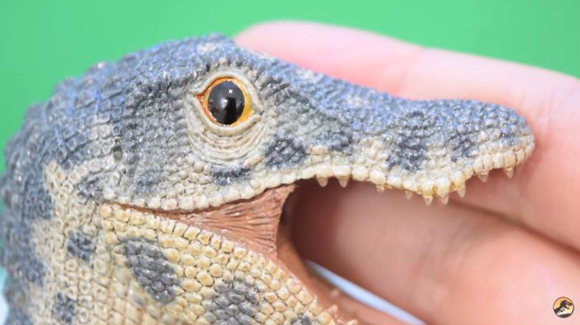Did Dinosaurs Sleep with One Eye Open?
A new study into the sleeping patterns and behaviours of crocodiles suggests that these reptiles are able to sleep with one eye open. The ability to sleep in this way probably evolved to help the animal’s stay vigilant and alert to danger. This phenomenon is termed unihemispheric sleeping. Half the brain rests whilst the other half, connected to the open eye remains alert. Mammals such as dolphins can do this along with some birds and reptiles.
Did Dinosaurs Sleep with One Eye Open?
If crocodiles and some birds are capable of unihemispheric sleep, could the dinosaurs have slept in this manner? Birds and crocodiles are the closest living relatives of dinosaurs, perhaps dinosaurs could sleep with one eye open?
Did Dinosaurs Sleep with One Eye Open?

A close-up view of the glossy eye of the Rebor hatching Baryonyx figure. Did dinosaurs sleep with one eye open?
Picture credit: Jurassic Collectibles
Studying Extant Reptiles
Researchers from the Max Planck Institute for Ornithology (Germany) along with colleagues from La Trobe University (Australia) studied the sleep patterns and behaviours of Saltwater crocodiles. These reptiles tended to sleep with both eyes closed but when another crocodile was introduced into their tank or a person approached, they kept one eye focused on the intruder. Dinosaurs may have been vulnerable when they slept, as close relatives of the Dinosauria, demonstrate unihemispheric sleep, it is intriguing to consider whether dinosaurs slept with one eye open.
To view the large range of dinosaur themed toys and educational gifts available from Everything Dinosaur: Dinosaur Toys and Gifts.
Extension Ideas and Activities for Schools
- Question. Why would some animals want to evolve the ability to keep alert whilst part of their body slept?
Answer. When animal’s sleep they are vulnerable to attack, staying vigilant in this way can help to keep the animal’s safe. In addition, some aquatic mammals are able to do this (dolphins etc.), they sleep with one eye open so that they can keep an eye on the rest of the pod. It stops them becoming detached from their social group.
- Question. In what other ways could sleeping animals keep themselves safe?
Answer. They could hide, for example in burrows, they could climb trees to keep themselves safe (many birds roost in trees), they could live in a group such as a herd. Whilst some herd members slept others could keep watch.
- Question, one aimed at more capable of learners tied in with KS3 studies. If unihemispheric sleep is found in some mammals, birds and reptiles all vertebrates that are not that closely related to each other how did this come about?
Convergent Evolution
Answer. This ability may have evolved in unrelated groups of animals independently, a case of convergent evolution, whereby similar characteristics evolve in unrelated animals as a result of having to adapt to similar environments or conditions. Alternatively, this ability could have evolved long ago, in the shared, common ancestor of modern birds, mammals and crocodiles.
Ask the pupils to think about other examples of convergent evolution, for example bird wings and those of bats – similar characteristics but ones that have evolved independently in unrelated animals.
Everything Dinosaur team members work hard helping customers with their questions and queries, to view our testimonials: Everything Dinosaur Testimonials.

